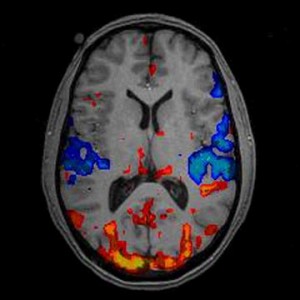Magnetic Resonance Imaging, or MRI, is used in many medical applications to gain an image of what is going on inside a patient’s body. It works because of humans’ unique molecular makeup. Because our bodies contain so much water, we are approximately 63% Hydrogen atoms. The protons in these atoms each possess a unique ‘spin’, or angular momentum. During an MRI scan, a radio wave pulse is sent through a large metal tube, which produces a very strong magnetic field ranging from 0.5 to 2.0 Teslas. This magnetic field interacts with the angular momentum of the Hydrogen atoms and aligns their spins in one direction (this is called ‘resonance’). At this point, the atoms are in a higher energy state, so when the field is removed, the atoms return to their lower energy resting state and give off a signal that is converted into a physical image.
Functional Magnetic Resonance Imaging, or fMRI, is a similar process, but rather than relying on atomic manipulation, fMRI measures changes in blood flow within the brain. It is known that when a particular region of the brain is actively firing, blood will flow there to supply needed energy. Because this blood is supplying energy, it comes from the lungs and contains a high level of oxygen, as opposed to blood that has been in circulation already and given off much of its oxygen content. This rush of highly oxygenated blood behaves uniquely in that it does not give off a magnetic signal, like other blood (it becomes ‘diamagnetic’). When an fMRI is performed and the strong magnetic field is applied to a patient’s brain, the diamagnetic blood interacts with the field much differently than the other surrounding blood. This allows scientists to map out exactly which regions of the brain are actively firing.
Learn more:
Raichle M. E., (2000) A brief history of human functional brain mapping. In Brain Mapping: The systems edited by Toga A.W. and Mazziotta J.C., Academic Press, pp33-75
http://www.radiologyinfo.org/en/info.cfm?pg=fmribrain
http://www.cis.rit.edu/htbooks/mri/inside.htm
http://www.physicscentral.com/explore/action/fmri1.cfm
http://www.radiology.mcg.edu/MRI_Physics/SpinGymnastics.pdf
http://www.fmrib.ox.ac.uk/education/fmri/introduction-to-fmri/
http://health.howstuffworks.com/medicine/tests-treatment/mri.htm
http://health.howstuffworks.com/medicine/tests-treatment/fmri.htm


